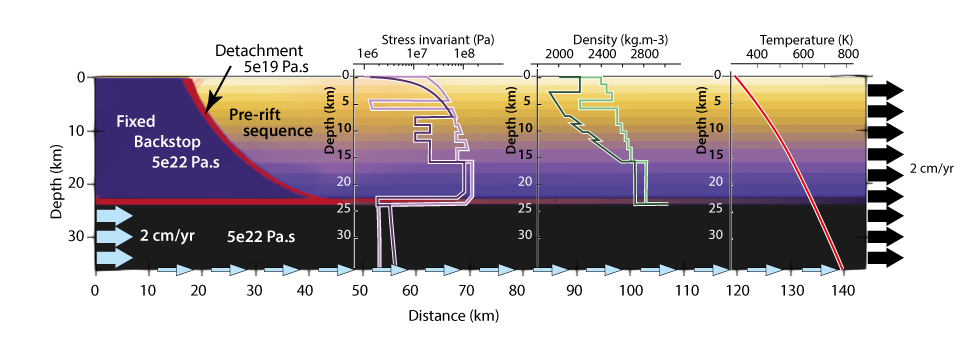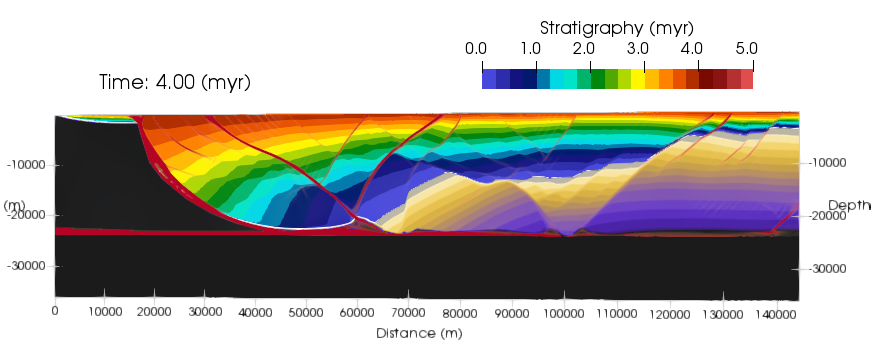PUBLIC McClay-Style Experiments Suite
Patrice F. Rey - BGH and Earthbyte Research Group, The University of Sydney, patrice.rey@sydney.edu.au
Software Used:
- Underworld 1.8
Model Setup:
 This suite of experiments is inspired by similar sandbox analog models from Kent McClay. Here, the aim is to develop an Underworld 2D template capable of matching the modelling outcomes of the best sandbox experiments. Our template represents a domain 144 km long and 36 km deep, the top 12 km of which is made of air-like material. There is 16 km of sedimentary rocks (pre-rift sequence) distributed over 10 layers, the top 10 are 1.5 km thick. Underneath, there is 8 km of stronger rocks (i.e. larger cohesion and coefficient of friction). We include a salt-like layer (constant density 2000 kg/m3, viscosity 1e19 Pa.s), either at the surface of the model, or within top section of the pre-rift sequence. The density of the sediments increases with depth either incrementaly or following a dependence on the confining pressure to simulate compaction. During extension, the progressive burial of the salt layer under sediments of increasing density results in a density inversion. In some models we impose a pseudo-isostatic condition at the base of the model, to maintain the lithostatic pressure constant. The wall to the right moves away at 2 cm/yr. To mimic sandbox kinematic boundary conditions, we i/ turn off the isostasy, ii/ impose a constant velocity at the base of the model, as well as on the vertical wall on the left where it meets with the lower basal layer, and iii/ we add a thin, low viscosity layer, to decouple the sedimentary sequence from the backstop and the bottom layer.
This suite of experiments is inspired by similar sandbox analog models from Kent McClay. Here, the aim is to develop an Underworld 2D template capable of matching the modelling outcomes of the best sandbox experiments. Our template represents a domain 144 km long and 36 km deep, the top 12 km of which is made of air-like material. There is 16 km of sedimentary rocks (pre-rift sequence) distributed over 10 layers, the top 10 are 1.5 km thick. Underneath, there is 8 km of stronger rocks (i.e. larger cohesion and coefficient of friction). We include a salt-like layer (constant density 2000 kg/m3, viscosity 1e19 Pa.s), either at the surface of the model, or within top section of the pre-rift sequence. The density of the sediments increases with depth either incrementaly or following a dependence on the confining pressure to simulate compaction. During extension, the progressive burial of the salt layer under sediments of increasing density results in a density inversion. In some models we impose a pseudo-isostatic condition at the base of the model, to maintain the lithostatic pressure constant. The wall to the right moves away at 2 cm/yr. To mimic sandbox kinematic boundary conditions, we i/ turn off the isostasy, ii/ impose a constant velocity at the base of the model, as well as on the vertical wall on the left where it meets with the lower basal layer, and iii/ we add a thin, low viscosity layer, to decouple the sedimentary sequence from the backstop and the bottom layer.
Conditions:
| Parameters (SI) | Sediment 0-16 km | Deep sediment 16-24 km |
|---|---|---|
| Reference temperature (K) | 273.15 | 273.15 |
| Reference density (kg m-3) | 1800 | 2700 |
| Compressibility (Pa-1) | 1.42x10^-9 | 1.42x10-9 |
| Thermal expansivity (K-1) | 3x10-5 | 3x10-5 |
| Thermal diffusivity (m2 s-1) | 1x10-6 | 1x10-6 |
| Radiogenic heat production (W m-3) | 1.2 x 10-6 | 0.6 x 10-6 |
| Heat capacity (J K-1 kg-1) | 1000 | 1000 |
| Max yield stress (MPa) | 100 | 100 |
| Initial cohesion (MPa) | 0 to10 | 0 to10 |
| Cohesion after weakening (MPa) | 0 to 2 | 0 to 2 |
| Coefficient of friction | 0.567 | 0.567 |
| Coefficient of friction after weakening | 0.112 | 0.112 |
| Saturation strain | 0.2 | 0.2 |
| Viscosity (Pa.s) | 1e22 | NA |
| Activation energy (kJ mol-1) | NA | 244 |
| Power law exponent | NA | 3.2 |
| Pre-exponential factor (MPa-n s-1) | NA | 1e-2 |
Results:
 This suite of experiments demonstrates that our Underworld 2D template is capable of delivering model outputs comparable to some of the best sandbox experiments facilities. Some of the advantages of our numerical sandox template include: i/ speed, as models can be set up in minutes and dozens of them can be run in 24 to 48 hours; ii/ our numerical experiments keep track of temperature, stress, strain rate, and accumulated strain; iii/ the pressure- and temperature-dependent density and rheology of each individual layers can be specified; iv/ isostasy can be accounted for; and v/ our template allows for time-dependent boundary conditions and simple surface processes.
This suite of experiments demonstrates that our Underworld 2D template is capable of delivering model outputs comparable to some of the best sandbox experiments facilities. Some of the advantages of our numerical sandox template include: i/ speed, as models can be set up in minutes and dozens of them can be run in 24 to 48 hours; ii/ our numerical experiments keep track of temperature, stress, strain rate, and accumulated strain; iii/ the pressure- and temperature-dependent density and rheology of each individual layers can be specified; iv/ isostasy can be accounted for; and v/ our template allows for time-dependent boundary conditions and simple surface processes.